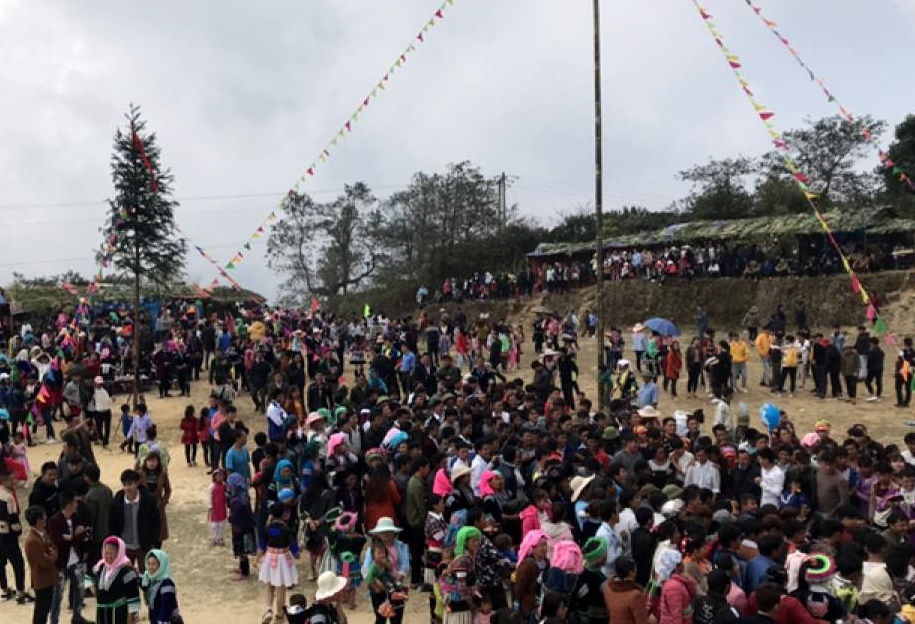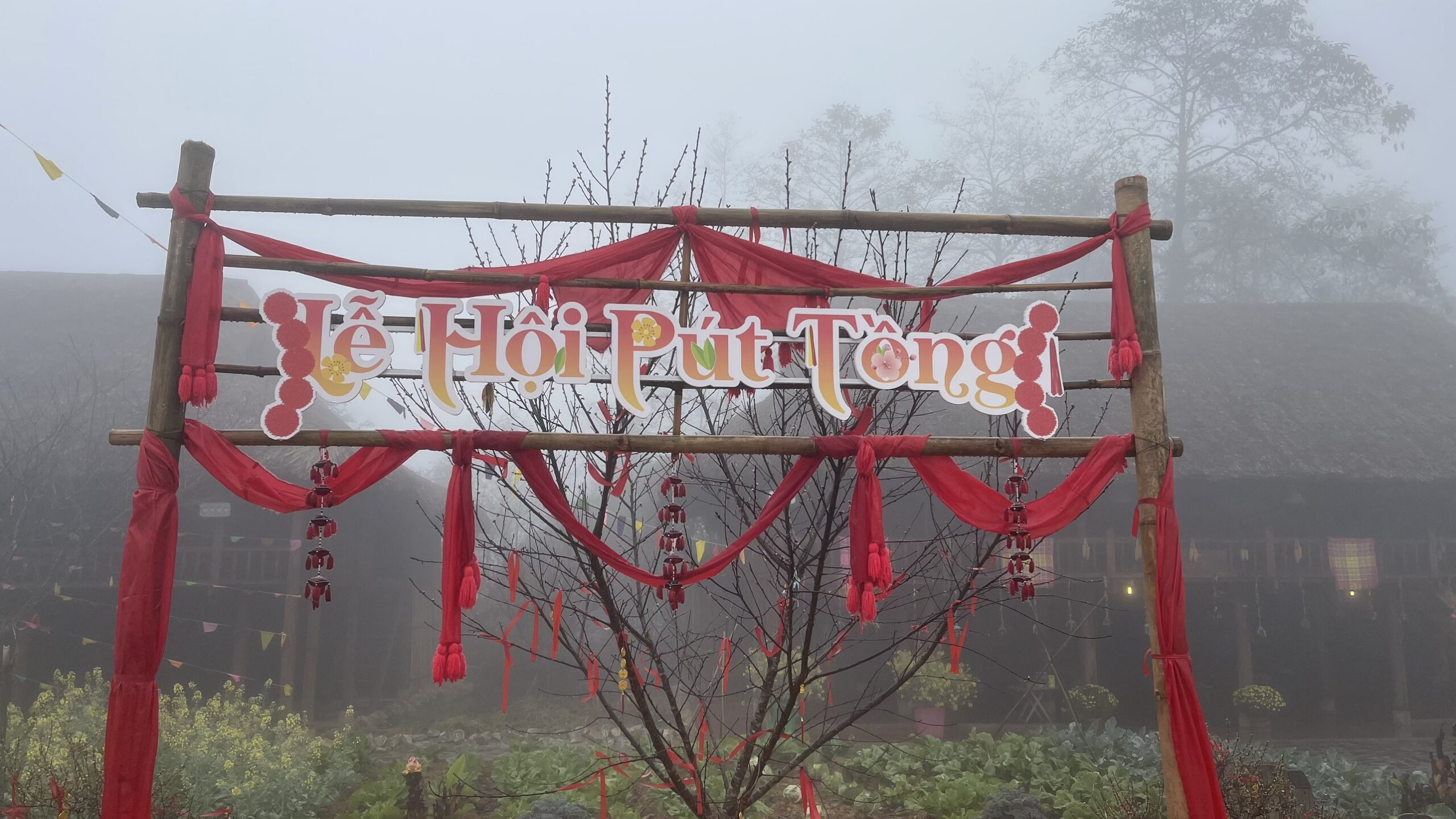- You are here:
- Home »
- About Sapa »
- Sapa’s Traditional Festival in Spring

Sapa’s Traditional Festival in Spring
Sapa is located in the North West of Vietnam, with spectacular picturesque terraced rice fields, special traditional culture of 5 ethnics group, fresh air, Sapa attracts many tourists annually. In Sprin Sapa has its unique features in each season, but coming to Sapa at this time, you not only can admire the beauty of this land but also can take part in many traditional festivals of ethnic minorities.
Gau Tao Festival
Gau Tao Festival is one of a few traditional festivals that are remained until these days of Mong people. Gau Tao means “Starting a new Crop”. Mong people believe that the Gau Tao festival represents the life of the head of the family. That’s why the head of the family has to prepare a new year tree so to conduct the rituals.
The Gau Tao festival is held from 2nd to 4th of January of the lunar calendar but the preparation always begins in November of the previous year. The head of the family has to prepare a full tray of food before chopping bamboo to plant a “New year tree”. The sorcerer sings a song to tell the gods the purpose of this festival and find a good bamboo tree for the rituals.

The festival officially begins after the rituals. The chosen families choose a singer to sing a song to wish the whole family health, luck, and success. After that all people can join, sing and dance.
In the festival, there are many games such as “con” throwing, lusheng dance, martial arts, bow shooting…. Many young unmarried men and women take part in these games not only to relax but also to look for a partner. The festival lasts for 3 days. After that, the host will announce the end of the festival before walking counter-clockwise around the tree and singing the song to lay it down.
Roong Pooc Festival
Roong Pooc festival is held on the first Dragon Day after the first full moon annually. Roong Pooc is a traditional festival of Giay people at Ta Van commune, Sapa district. This festival aims at showing people’s gratitude towards their guardians. On its very first day, Roong Pooc was just held in the Giay community but now it has spread among Muong Hoa valley and become onea famous festival of Sapa.
This festival is held to hope for a secure life, abundant harvest, favorable weather, good health for people. The most ideal place to hold the festival is the flat field at the end of the village. There is a pillar with a circle board on top. One side of the pillar is glued with a red piece of paper and the other side is glued with a yellow one.

People put the offerings on the altar, including cloths, eggs, bamboo shoots, silver, and 6 colorful balls. After that, an elder will burn incense sticks and send prayers towards deities for all the best things in life, including health, property, happiness, peace… The sacred ceremony will end with the harmony of drums, gongs, and Pi Le clarinets. And now, come to the next part: traditional games.
The festival starts with the “Con” throwing game. The predecessor of the village will go first, then males and females will follow. They stand in 2 lines, throwing 6 colorful balls into the air. The other traditional games include catching goats while blindfolded, going a bamboo bridge over a stream, etc.
Long Tong festival
Long Tong festival is considered a religious event reflecting the desire of good weather and crops. It usually takes place in the biggest area with highest quality on the field, it is the first festival in a year of Tay ethnic.
Long Tong in Tay’s Language means “Starting a new Crop”, it viewed as religious activities prayed for good weather, lush trees, harvests and prosperous life. They organize this festival in the best and biggest field with the meaning the first day for work of Tay people is the day work on the field. There are many traditional game in this festival: “Con” throwing; Cockfights by banana flower, Buffalofights by asparagus… The festival is also the occasion for old people find ex-friends and young people can look for sweetheart.

Put Tong Festival
Put Tong is the most important ritual in the ancestor worship belief of the Red Dao people. In Dao language “Put Tong” means “Dancing Festival” . Put Tong is both a performance method performed during ceremonies and also means a worship ritual to commemorate the ancestral souls of the Red Dao people. The birth of the Put Tong ritual is associated with a number of legends about the migration of the Dao people.
Put Tong ceremony includes 11 steps and most of the worshiping rituals are performed through dance movements. The dances are performed one after another throughout the ritual process, the prayers are almost included in the dances. While dancing, they sing to the gods and dances are used as a form of pleasing the gods, expressing deep gratitude to ancestors, gods, and saints.

Dance in the Put Tong ritual is usually only practiced by men, partly reflecting the social and patriarchal family structure of the Red Dao people. Priests and dancers set secret rules to protect men’s exclusive role in rituals.
In addition, residents and tourists can directly participate in attractive folk games during the festival such as competing on bamboo bridges across streams, climbing poles to get gifts, mountain running, blindfolded pig catching games, tug of war. … and enjoy attractive musical performances of Red Dao ethnic.
“Village Sweeping” Festival of Xa Pho group
The village Sweeping festival of the Xa Pho people in Sapa means praying for a peaceful new year, lush vegetation, healthy vegetation, and vibrant fertility. The festival takes place regularly on the Horse and Goat days of the second lunar month.
At the beginning of the Village Sweeping Festival, each villager will bring a chicken, a bowl of rice, incense, and wine to the place to hold the ceremony. There are some villager can bring more dogs, goats, or pigs to contribute for this festival, then the other villagers have to work to help them for one day.

On the day of the holiday, the men in the village will bring offerings to an open field at the beginning of the village. The assigned people will work together to slaughter chickens, pigs, goats… to prepare for the festival.
When the offerings have been made, the shaman sets out 8 pairs of chopsticks, 8 bowls, and 8 cups of wine. The shamans sit in line in front of the offering tray and begin the ceremony.
At last take a bamboo branch and stick it around the ground, then use a dog’s tail and ears to stick it in the ground to prevent ghosts from entering the village, then the shaman will light a fire for people to walk through before coming home.
To Uyen
About the Author Sapa Tourism Office
Popular posts

